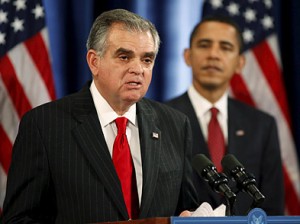
The Administration has delivered a historic compromise in the face of what looked to be overwhelming odds against it.
The U.S. Department of Transportation (DOT) and the U.S. Environmental Protection Agency (EPA) today jointly established new federal rules that set the first-ever national greenhouse gas emissions standards, and will increase the fuel economy of all new passenger cars and light trucks sold in the United States.
Starting with 2012 model year vehicles, the rules together require automakers to improve fleet-wide fuel economy and reduce fleet-wide greenhouse gas emissions by about 5% every year.
NHTSA has established fuel economy standards that strengthen each year, reaching an estimated 34.1 mpg for the combined industry-wide fleet for model year 2016.
The rules, with a claimed cost of $52 billion and benefits of $240 billion, are compromised or the results of compromises in several areas, depending on your point of view. The vast majority of buyers will not see fuel economy anywhere near 34 mpg.
Because credits for air-conditioning improvements can be used to meet the EPA standards, but not the NHTSA standards, the EPA standards require that by the 2016 model-year, manufacturers must achieve a combined average vehicle emission level of 250 grams of carbon dioxide per mile. The EPA standard would be equivalent to 35.5 miles per gallon if all reductions came from fuel economy improvements.
Perhaps more worrisome from policy and health points of view are exemptions for the gas guzzling, CO2 belching vehicles that the rich buy.
DOT and EPA received more than 130,000 public comments on the rules proposed in September 2009, and officials said there was “overwhelming support” for the new national policy. This means that automakers will be able to build a single, light-duty national fleet that satisfies all federal requirements, as well as the standards of California and other states.
The collaboration of federal agencies also allows for clearer rules for all automakers, instead of three standards (DOT, EPA, and a California standard), and was a clear victory for the Obama Administration that negotiated it after decades of gridlock and legal maneuvering.
The joint rules are also a sign of the decreasing political influence of automakers, which had long blocked fuel economy increases, and recognition of a growing green sentiment among voters.
What happens after 2016 is still a potential problem for automakers, since it is expected that the California Air Resources Board will attempt, via another waiver request, to decrease further CO2 emissions, which also becomes defacto an increase in the fuel economy required in new cars.
California, joined by 13 other states, had previously been denied just such a waiver request under the Bush Administration.
It took a Supreme Court ruling to give the Obama Administration the legal means to negotiate an historic compromise in the face of what looked to be overwhelming odds against it, given the large differences among political, regional and economic factions, most of them well funded in “pay to play” Washington.
The Administration also managed to coordinate two large federal agencies as part of the compromise. When Obama took office, the National Highway Traffic Safety Administration, part of DOT, was promulgating new fuel economy standards as required by Congress under the Energy Independence and Security Act of 2007; while EPA was preparing greenhouse gas standards under the Clean Air Act.
Automakers already are pushing to preempt states from attempting to get back in the business of emission standards.
“Today, the federal government has laid out a course of action through 2016, and now we need to work on 2017 and beyond,” said Dave McCurdy, President of the Alliance of Automobile Manufacturers, almost immediately after the regulations were revealed.
Secretary of Transportation Ray LaHood said, during a call with reporters I participated in, that no consideration has been given to what happens beyond 2016, as agency staffers have been working 24/7 to get this rule finalized.
“Post 2016 will begin as soon as the ink is dry, and people have had a chance to recover,” said LaHood.
According to government officials, the new rules could potentially save the average buyer of a 2016 model year car $3,000 over the life of the vehicle. Nationally, the regulations will conserve about 1.8 billion barrels of oil and reduce nearly a billion tons of greenhouse gas emissions over the lives of the vehicles covered. It’s said to be the equivalent of taking 50 million cars off the road.
EPA claims the cost is $950 per car, and clearly, the government is counting on radical cost reductions during the next several years to hold down the price of new vehicles.
However, some of the vehicles being sold now or coming in the near future will carry price tags far in excess of this because of expensive technologies, such as high pressure direction-injection and turbocharging, or in the case of plug-in hybrids an electric vehicles, lithium ion battery packs, which alone cost about the price of an economy car today.
“By working together with industry and capitalizing on our capacity for innovation, we’ve developed a clean cars program that is a win for automakers and drivers, a win for innovators and entrepreneurs, and a win for our planet,” said EPA Administrator Lisa Jackson.
